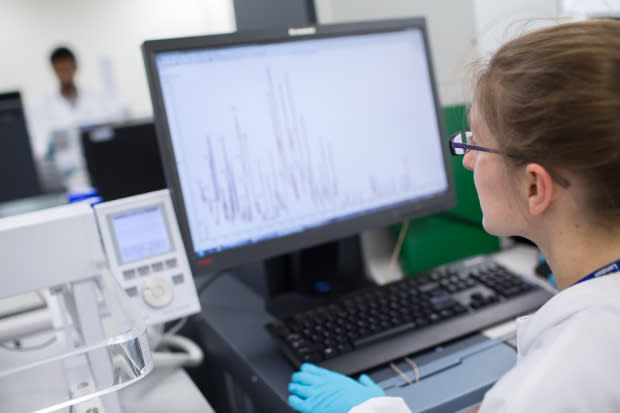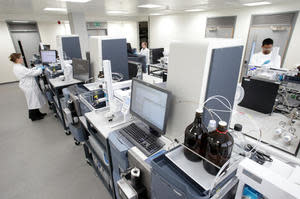Why your urine could usher in an era of personalised medicine

The National Phenome Centre
Image: Thomas Angus / Imperial College
The drug Tamoxifen helps prevent breast cancer from spreading in some women, but in others it is much less effective.
Knowing which patients would benefit from drugs like Tamoxifen, where patients can respond so differently, would be a boon to healthcare. But medicine today is still something of a blunt instrument, tailored to everyone and no-one.
In the past medicines like Tamoxifen were applied to broad swathes of the population, as tools were not available to take into account the myriad idiosyncratic ways pharmaceuticals can interact with our bodies.
Yet healthcare is on the cusp of a new era of personalised treatment, where drugs will be tailored to the biochemistry of smaller groups and be accurately targeted to individuals.
Underpinning this shift will be a greater understanding of the biochemicals produced when our bodies metabolise our digested food - breaking it down into the likes of amino acids, vitamins, sugars and fats to produce energy and raw materials for building cells - as well as of how these molecules change in response to disease.
This deeper insight is being generated by instruments analysing the chemical make-up of our bodies, at a level of detail that would previously have been impossible.
One centre at the forefront of this research is the National Phenome Centre in the UK, which is led by Imperial College London and King's College London. The centre is screening samples of urine and blood serum and plasma from thousands of individuals for endogenous metabolites.
Carrying out this analysis are machines similar to those used to monitor athletes' urine and blood samples for drugs during the London 2012 Olympic Games. Tim Kelsey, NHS England director for patients and information, dubbed them the first molecular diagnostic machines in the UK and compared the volume of data they are producing to that generated by Cern's Large Hadron Collider, as they record the chemical make-up of the metabolites in each sample.
What your urine says about you
How could understanding more about these metabolites help diagnosis? Primarily by letting doctors know more about a patient simply by studying samples of bodily fluid, such as blood or urine. And it turns out that once you know what to look for - the right chemical fingerprints - that someone's urine can tell you an awful lot about them.
"Once you've got the fingerprints they allow you to tell how old somebody is, their BMI, their gender, diet, what drugs they're taking and the nature of their disease. You can gather a huge amount of information about the biochemistry of people just from a drop of blood or urine," said professor Ian Wilson, chairman of drug metabolism and molecular toxicology at Imperial College London.
Biochemical markers in someone's urine can even give you a good shot at working out a person's nationality, for example the Swedish fondness for eating fish leaves a telltale trail, or, more usefully, learn whether they are likely to be suffering from a range of diseases, such as diabetes.
One of the ways the centre is looking to enhance diagnosis Wilson said is by analysing samples from epidemiological studies. The process involves "taking metabolic profiles of large numbers of people in the population and trying to work out whether there is a metabolic signature that indicates a propensity for a particular type of disease". In the long run the work should play a significant role in improving detection of a wide range of illnesses.
"Instead of just saying 'These people are different', you can go into the data and ask 'Why are they different?' and when you know why they are different you can say 'These people have all got diabetes and the thing that makes them different is glucose'."
This information could help doctors be more proactive in preventing disease, he said, for example allowing them to spot individuals likely to get diabetes based on their lipid profiles and who would benefit from changing their lifestyle.
Just as important as identifying chemical indicators of disease is learning which markers indicate how a patient is likely to respond to a particular form of treatment.
These biomarkers could provide clues as to how patients will respond to drugs, with the varying effectiveness of the breast cancer drug Tamoxifen being a classic example of how a person's metabolism can affect the impact a treatment has.
"You could use it in a more 'What the is going on in this tumour metabolically compared to that tumour?' way. Frankly doctors in general don't have any problem diagnosing whether a person has cancer or not. What they have a lot of problem with is working out how to develop drugs to hit those cancers, which if they've got different biochemistry might be differentially sensitive," Wilson said.
"You can also look at a metabolic profile and say 'This tumour is this kind of cancer, I need to treat it in this way. This tumour, although it's a lung cancer as well, has a different background genetics which is leading to a different background metabolism, and I need to treat it this way'.
"The other thing you can perhaps begin to do, based on a particular set of metabolic profiles obtained during the patient's journey through therapy, is to say 'It started off as this kind of cancer but we hit it with drugs which has forced it to evolve into this type of cancer and I need to change my therapy accordingly'."
"You have a tool here that can be used at a variety of levels, from diagnosis, through mechanistic understanding, and potentially through prognosis."
Dusting for chemical fingerprints
To map the chemicals that make up a person's metabolites, samples are analysed using two types of machines, Nuclear Magnetic Resonance (NMR) Spectrometers and Mass Spectrometers.
"We use types of analytical chemistry that garner huge amounts of metabolic information," said Wilson.
"They have different properties as analytical detection systems but with the two of them together we believe we obtain a more comprehensive coverage than anybody else.
"Obviously we'd like to know everything about a person's metabolic profile but, of course, that's a type of perfection that's difficult to achieve because how do you know you've measured everything. Let's not go into Donald Rumsfield territory but it's exactly that," he said, referencing the former US vice president's "unknown unknowns" quote.

Inside the National Phenome Centre
Image: Thomas Angus / Imperial College
While one person can pick out chemical signatures from the NMRs' output, the size of the centre's datasets meant it isn't feasible to manually annotate the biochemical changes detected in the samples.
"I can look at an NMR spectrum and say 'Normal, normal, sick'. But can I do that with 10,000 NMR spectra? No, I would die of boredom first."
Instead researchers rely on computers to trawl the resulting data and correlate chemical traces with how individuals respond to drugs or incidences of disease. Machines spot these links using multi-variant statistical analysis, such as principle components analysis and advanced pattern recognition techniques.
For each individual up to 40GB of chemical fingerprint data is generated, with can add up to about two petabytes of raw data each year, which is stored for analysis and archived to tape. Data analysis is carried out using a mixture of proprietary and in-house software, running under Linux, Windows, and Mac OS X.
The centre will receive £2m a year until 2017, during which time it must demonstrate that it can provide insights at a population level that will support personalised medicine.
Wilson believes that metabonomics is at the same stage today as genomics was in the year 2000, when US president Bill Clinton said the field was going to revolutionise medicine - a promise Wilson said is now beginning to come true.
"There are a lot of scientists in the world trying to do this type of metabolic profiling. We're now trying to apply this on an industrial scale."
He hopes that within the decade discoveries made at the National Phenome Centre will have had an impact on healthcare, predicting a steady flow of improvements to the quality of treatment and diagnosis - as has been the case with genomics.
"We know that the human genome didn't come good straight away but it's sure as hell starting to come through now. There's no one major thing you can point at and say 'It's revolutionising everything' but it is slowly revolutionising everything."

